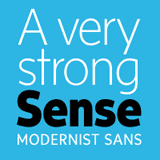|
|
 |
|
|
 | Page 1 of 2 | | 
 | | Exclusive Interview |
By: Brendan Staunton
Page 1 of 2 "Take the Parthenon - the famous flutings on the columns. What are they there for? To hide the joints in wood - when columns were made of wood, only these aren't, they're marble... Your Greeks took marble and they made copies of their wooden structures out of it because others had done it that way. Then your masters of the Renaissance came along and made copies in plaster of copies in marble of copies in wood. Now here we are, making copies in steel of copies in plaster of copies in marble of copies in wood. Why?" Ayn Rand - 'The Fountainhead'
(discussing architecture)
Gareth Hague speaks very quickly - a stream of words and ideas pouring forth as I sit across from him, grateful for the convenience of my tape recorder. Gradually, I notice one theme which continues to emerge and re-emerge from what he says. "I'm trying to give our fonts their own context. I don't want to say: 'such-and-such a font is based on woodcuts' or something like that. I want to lead off somewhere else other than just craftsmanship." "So you're interested in creating your own reasons for doing your work." "Yes... I'm interested in doing work that is more expressive and less about rules and shapes and drawing and structure and manufacture - and more about something else, whatever that something else is." That 'something else' could be the key to Alias fonts. Traditional typeface design and its modern computer-based equivalent could not be more different. Nowadays new skills are required for new media going out to new markets. Different things work; different things don't. Reading from a screen, as opposed to a page, is just one of many modern developments, placing new demands on the design of type. Gareth Hague believes these developments are changing the nature of the discipline and that the new digital fonts should be seen and judged in their own right without reference to historic notions of craftsmanship. "That whole English tradition of type design - I just don't find it interesting." Alias fonts were originally born out of necessity. Unable to find suitable faces for their innovative design work, David James and Gareth Hague decided to make up their own. "We drew the fonts ourselves to make the message of our work more cohesive and these faces sprang from that process." As with other designers, the acquisition of a computer meant they could create their fonts with greater accuracy and expand the techniques which come from drawing freehand. Unlike with other designers, the process was not all one way. Sometimes the computer was used to perfect original hand drawings; other times the inspiration came from the computer itself. "Granite and Elephant, which were the first two that I did, had no non-digital history at all. They were both drawn entirely on the computer." It's this philosophy - not so much innovation on the computer as innovation in the use of the computer - which has characterised the work of David James and Gareth Hague in the past and which informs the development of Alias fonts now. "It evolves. You understand more because of what you do. When I did the first one I didn't really know how to construct a typeface, so obviously there was a learning process. Basically Elephant started out as this font with a strong vertical stress and a thinner horizontal stress - the interaction of those via a system of very rigid, circle based curves." "How did you feel about the way it was used - on Loaded magazine? Did you ever imagine...?" "When they phoned up, I thought it was perfect for them because Elephant, as a face, is almost... vernacular in a way." "Vernacular?" "Yes - in the sense that it was created by someone other than a professional or a craftsman. I was just doing it to see what would happen. It has lots of naive, basic, rough-edged qualities about it. And, of course, they mess about with it a lot too. They make it very big and very bold." | | |
|  |  |
|  |  |
| | | Page 1 of 2 | next  |
 |
|
 
  

 | Guest |  |
 |
0 items |
 |
View |
 |
| Total |
 |
$ 0.00 |
 |  |
| |
|
| 
Receive regular e-news bulletins packed with new releases and special offers!
|
|
|
Key benefits:
- shop without c/card
- monthly invoice
- purchase history
- backup resource
- premium content
|
|
| |
|  |
|  |
| |
|
| |
|
|
|
|
|
 |
|
|
|
|


